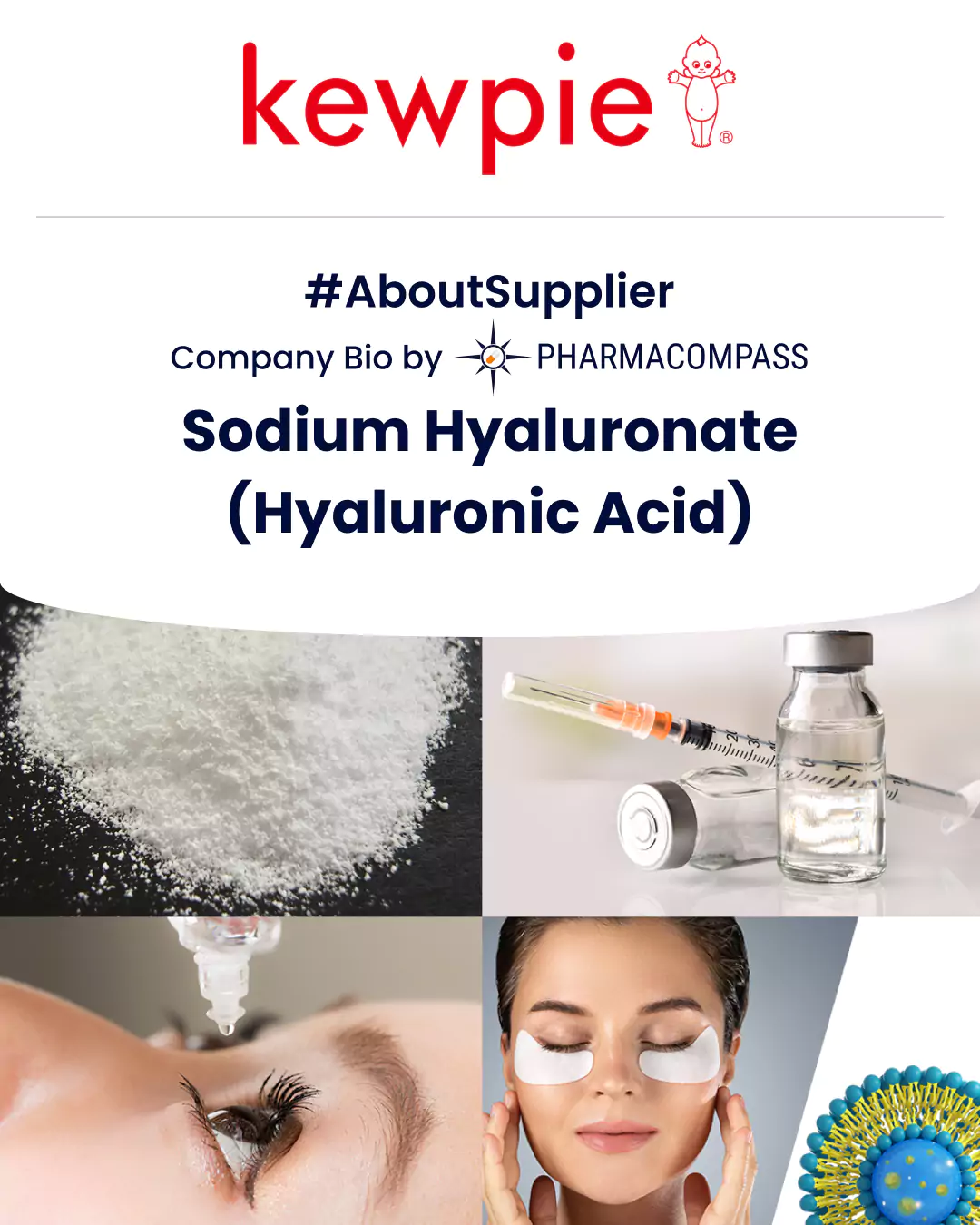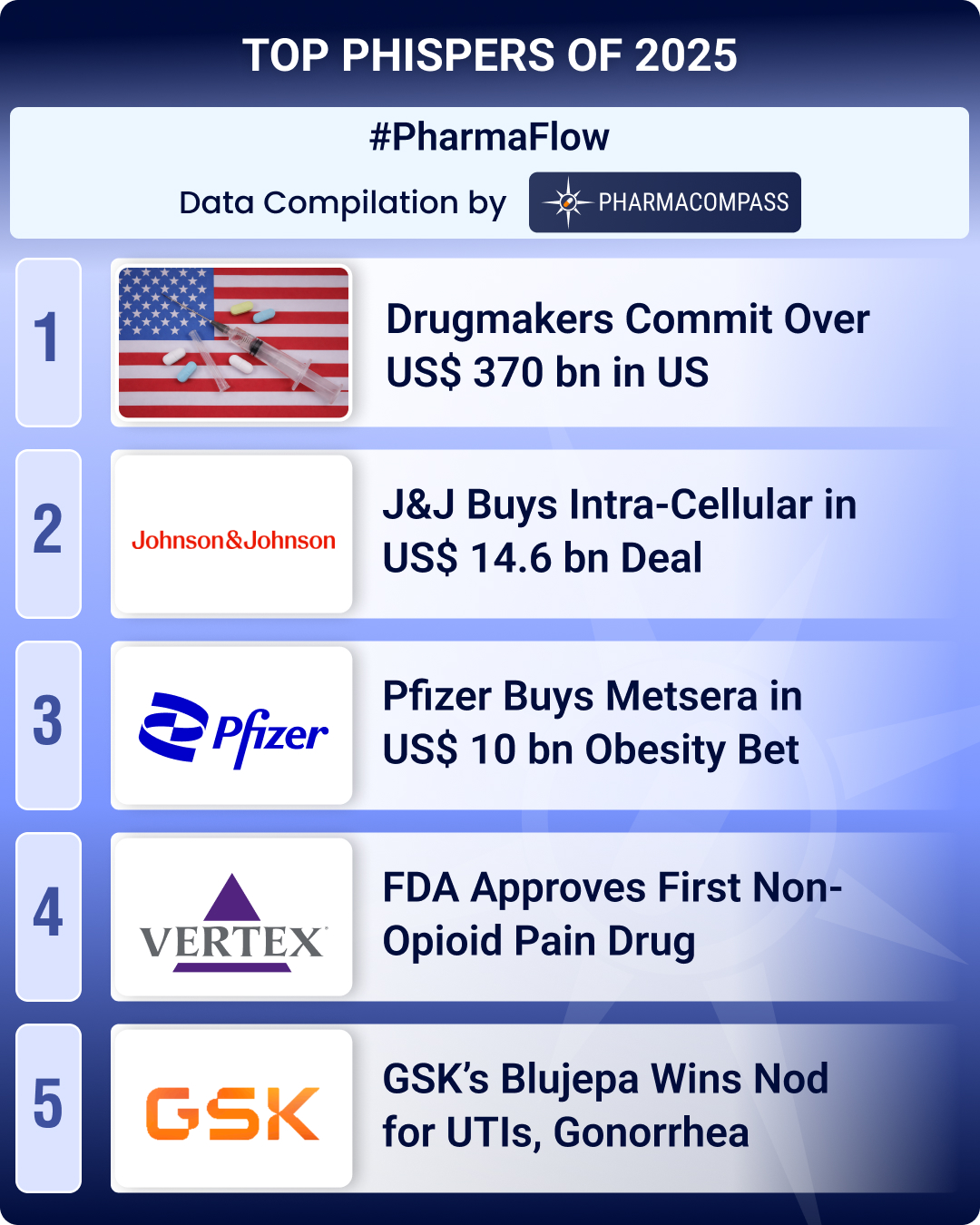
By PharmaCompass
2023-07-05
Impressions: 4597
View Kewpie's pharmaceutical grade Sodium hyaluronate & browse its different grades of Hyaluronic Acid for injectables & eye drops on PharmaCompass.
What is Sodium hyaluronate (Hyaluronic acid) and what are its properties?
Sodium hyaluronate is the sodium salt of Hyaluronic acid (HA) which is a mucopolysaccharide made up of glucuronic acid and N-acetylglucosamine. Hyaluronic acid is distributed throughout the body, such as in the human skin (high concentrations are found in the epidermis/dermis), synovial fluid, and the vitreous body of the eyes.
Hyaluronic acid is also known by several other names, such as HA, hyaluronan, hyaluronate, and Sodium hyaluronate. The molecular weight of Sodium hyaluronate is lower than the molecular weight of HA. It is, however, small enough to penetrate the epidermis, or top layer of skin, to improve hydration from the underlying skin layers, resulting in a greater hydrating effect.
Hyaluronic acid is an elastoviscous fluid composed of hylan polymers, which are derivatives of hyaluronan, a naturally occurring complex sugar. The physiological functions of Hyaluronic acid include anti-aging, wound healing, protection against infection, and collagen fiber biosynthesis.
The sources of Hyaluronic acid include bovine tracheas, bovine vitreous, rooster combs, and plants. Industrial production of Hyaluronic acid is based on either its extraction from animal tissues or large-scale lactic acid bacterial fermentation with genetically engineered strains. Plant-based HA is extracted from microbial fermentation in addition to animal-based Hyaluronic acid.
A majority of the industries use Hyaluronic acid supplements for joint diseases, particularly inflammation. Sodium hyaluronate is used to alleviate knee pain in patients with osteoarthritis who have not found relief from other treatments. Hyaluronan is found in higher concentrations in synovial tissue and fluid, along with other soft connective tissues. Sodium hyaluronate also plays a key role in cell proliferation, cell migration, matrix assembly, and tissue development, and may also be involved in the advancement of some malignant tumors.
Hyaluronic acid comes in five different sizes and molecular weights that permeate various layers of the skin. Because molecules with lower molecular weight are smaller, they can reach deeper layers of the skin. Hyaluronic acid’s molecular weight is significantly dependent on its source; however, refinement of the isolation procedures has resulted in the commercial availability of a wide range of molecular weight grades.
The physical properties of Sodium hyaluronate are mentioned below:
- Purified Sodium hyaluronate is a white powder with no taste or aroma.
- The molecular weight of the Sodium hyaluronate molecule is around 4,000 to 80,00,000 Daltons.
- Sodium hyaluronate has high solubility and viscosity.
- It provides excellent moisture-holding ability and elasticity, as well as a lubricating effect.
- Sodium hyaluronate is compatible with biological systems.
- It degrades with heat, enzymes, etc. but can be stabilized by crosslinking.
- It is stored as a dry powder at 5°C and as a solution at -20°C or lower.
- Sodium hyaluronate is photosensitive and moisture sensitive, so it should be kept away from light and humidity.
Based on its degree of penetration, HA can be classified into high molecular weight Hyaluronic acid (HMW HA) > 18,00,000, middle molecular weight Hyaluronic acid (MMW HA) 10,00,000 - 18,00,000, low molecular weight Hyaluronic acid (LMW HA) 4,00,000 - 10,00,000, small molecular weight Hyaluronic acid: 1,00,000 - 4,00,000 and extra small molecular weight Hyaluronic acid: < 100,000.
The high molecular weight Hyaluronic acid moisturizes the surface of the skin, protects the skin’s barrier, and improves its elasticity. It also contains anti-inflammatory properties that can help soothe sensitive or irritated skin. Low molecular weight Hyaluronic acid, on the other hand, can more easily penetrate the skin and is most effective in reducing wrinkles. In addition, topical low molecular weight HA can be used as an alternative to treat facial seborrheic dermatitis.
What are the different applications of Sodium hyaluronate in the pharmaceutical and cosmetic industries?
Hyaluronic acid is a naturally occurring polysaccharide biopolymer. It is involved in a variety of biological processes including tissue hydration and structural scaffolding. Sodium hyaluronate is increasingly being used as a reagent in pharmaceutical, bioengineering, and medical applications. Exogenous Sodium hyaluronate has been investigated as a drug delivery system for treating cancer, ophthalmology, arthrology, pneumology, rhinology, urology, aesthetic medicine as well as in the cosmetics industry.
Sodium hyaluronate is used in numerous pharmaceutical and cosmeceutical applications which include:
Drug Delivery Systems: Hyaluronan is biocompatible, viscoelastic, and non-immunogenic. These Sodium hyaluronate characteristics have several medical applications in drug delivery for ophthalmic, nasal, pulmonary, parenteral, and dermal routes.
Scaffolds for Tissue Engineering: As a component of the extracellular matrix (ECM), Sodium hyaluronate is responsible for various structural properties of tissues and is involved in cellular signaling. Scaffolds made of Sodium hyaluronate are employed in bone tissue, space-filling, nerve, and brain tissue repair, as well as cell delivery, cell adhesion, and muscle regeneration.
Adjuvant to Anticancer Drugs: Medical applications of Hyaluronic acid include its use in the delivery of anticancer drugs because of its superior biocompatibility, biodegradability, and precise targeting of cancer cells.
Intra-Articular Injection: Sodium hyaluronate is taken as a supplement alone or in conjunction with collagen, vitamins, chondroitin sulphate, or glucosamine for joint-related problems as well as for the treatment of osteoarthritis. Hyaluronic acid binds efficiently to water, forming a viscous fluid that serves as a lubricant and a shock absorber within the joint. It also helps to increase bone density, mobility, and strength.
Ophthalmic Viscosurgical Devices: Ophthalmic grade Sodium hyaluronate is commonly used in viscosurgical devices (OVDs), which are essential in ophthalmic surgeries like cataract extraction, cornea transplantation, glaucoma, intraocular lens (IOL) implantation and vitreoretinal surgery. Sodium hyaluronate is a naturally occurring component of the eye’s vitreous humor and is entirely biocompatible.
Eye Moisture Retention: Sodium hyaluronate eye drops can alleviate dry eye symptoms by boosting tear production and stabilizing the corneal surface. Eye drops with high-molecular-weight Hyaluronic acid have anti-inflammatory properties.
Wound Healing: In topical preparations, Sodium hyaluronate is used to protect skin ulcers, burns, or wounds from irritation, allowing the skin to heal properly. Hyaluronic acid works to heal wounds by producing the granulation tissue required for wound repair.
Skin Benefits of Sodium Hyaluronate: Hyaluronic acid can retain moisture in the extracellular matrix formed in the gaps between cells. Its topical treatment hydrates the skin and keeps it hydrated as a humectant. Sodium hyaluronate is used in anti-aging preparations to help minimize the skin roughness, considerably reduce wrinkle depth and improve skin firmness and elasticity.
Dermal Fillers: Hyaluronic acid injections can be used to improve the skin's contour and decrease depressions caused by scars, injuries, or lines. Dermal fillers containing Sodium hyaluronate have been used to treat wrinkles, nasolabial folds, and fine lines around the mouth, lips, cheeks, chin, etc.
Furthermore, Hyaluronic acid promotes cell proliferation, cell differentiation, and immunosuppression, and is a component of submucosal injection and resorbable adhesion barriers.
In addition, high molecular weight Sodium hyaluronate forms a moisture protecting film at the surface of the skin, helps the skin to hold moisture, inhibits bacterial growth, and reduces UVB-induced apoptosis and inflammation in human epithelial corneal cells. Middle molecular weight Hyaluronic acid helps tighten the skin and keep it moisturized for a long time.
Low molecular weight Hyaluronic acid, on the other hand, is smaller, penetrates deeper into the dermis, moderately dilates capillaries, increases blood circulation, and ensures that water is stored in the connective tissue of the skin, making skin firmer and reduces visible wrinkles.
How is Kewpie considered a pioneer in the pharmaceutical industry for manufacturing Sodium hyaluronate?
Kewpie is a leading Japanese pharmaceutical grade Sodium hyaluronate manufacturer and supplier. It manufactures Hyaluronic acid which is used as an API and a pharmaceutical excipient. It created the first Sodium hyaluronate from chicken comb.
Since 1983, Kewpie has been a pioneer Hyaluronic acid manufacturer and supplier. Its R&D team can develop Sodium hyaluronate derivatives to meet the needs of the clients. Kewpie extracts and refines different active ingredients for foods, cosmetics, and pharmaceuticals at its fine chemicals division. It has been developing and manufacturing medical devices using Sodium hyaluronate since 2016.
Kewpie is one of the leading Sodium hyaluronate suppliers, exporting Sodium hyaluronate to more than 30 countries. It is a prominent pharmaceutical grade Sodium hyaluronate manufacturer in Japan and can meet the clients’ requirements for tailor-made derivatives. To assure the supply of safe products, Kewpie’s production and quality control (QC) systems are based on Good Manufacturing Practice (GMP). It follows procedures and conducts quality testing at every stage, from receiving raw materials to manufacturing and shipping, and has developed control systems to ensure quality.
Kewpie is a leading Sodium hyaluronate producer, offering pharma grade, medical grade, ophthalmic grade, and cosmetic grade Sodium hyaluronate with molecular weights ranging from 800 Da to 35,00,000 Da. It can meet the specific needs of the clients by adjusting the molecular weight. Kewpie not only offers products of biofermentation origin, but it also has natural products, thanks to its advanced extraction and refining technology.
Kewpie provides custom-made Sodium hyaluronate derivatives by binding other functional compounds to Sodium hyaluronate, which can acquire new functions and physical characteristics. Kewpie promotes the timely development of products with technical support from R&D experts and regulatory support.
Kewpie offers high-quality pharmaceutical grade Sodium hyaluronate. It can produce highly pure and stable products that can maintain the safety and efficacy of the final drug by using its manufacturing knowledge.
Kewpie offers ophthalmic grade, pharma grade as well as food, cosmetic and medical grade Sodium hyaluronate. Its Sodium hyaluronate is good for injections, eye drops (ophthalmic solutions), pharmaceuticals, external preparations, and medical formulations.
Production of Hyaluronic acid at Kewpie’s facility occurs through two methods - microbial fermentation and extraction from chicken comb. Kewpie has completed several Hyaluronic acid R&D projects since 1983. Kewpie is a leading producer of Hyaluronic acid. It has the technology to control the molecular weight of Sodium hyaluronate to produce it according to customers' needs.
Various products developed and offered by Kewpie include Hyabest®(A), Hyabest®(J), Hyabest® (S) LF-P, Hyalo-Oligo®, Hyaloveil®-P, Hyalorepair®, and HAbooster™ which are mentioned in detail below:
- Hyabest®(A): It is a low-molecular weight Hyaluronic acid with anti-inflammatory and other properties.
- Hyabest®(J): It is an injectable Hyaluronic acid that works on joints.
- Hyabest® (S) LF-P: It is an edible version of Hyaluronic acid that is effective against skin damage from ultraviolet radiation. So, it acts as an anti-aging substance.
- Hyalo-Oligo®: It has a different moisture retention mechanism from other products. So, it is used in parallel with conventional products.
- Hyaloveil®-P: It acts as an adsorbent of Hyaluronic acid for hair and skin and continues to retain moisture.
- Hyalorepair®: It is a blend of oil with Hyaluronic acid. It restores the barrier function, preserves skin moisture, and repairs rough skin.
- HAbooster™: In addition to the functionality of conventional Hyaluronic acid in retaining skin moisture, it acts to promote collagen metabolization.
Kewpie is a pioneer Sodium hyaluronate producer. It produces its products in accordance with Good Manufacturing Practices. It is also one of the leading Sodium hyaluronate suppliers in the world.
What are the different grades of Sodium hyaluronate (Hyaluronic acid) offered by Kewpie?
Kewpie is a Hyaluronic acid manufacturer and supplier that has been in research for more than 30 years. Kewpie offers safe to use pharma grade, cosmetic grade, food grade, and medical grade Sodium hyaluronate.
Pharmaceutical Grade Hyaluronic Acid
Kewpie is a pharmaceutical grade Sodium hyaluronate manufacturer, which produces various Sodium hyaluronate grades, including injectable grade and ophthalmic grade HA at its manufacturing facility near Tokyo. It is a producer of Hyaluronic acid for eye drops, injections, as well as external preparations.
Kewpie manufactures purified Sodium hyaluronate as hyaluronsan HA-AML and hyaluronsan HA-SHL. These are usually used in pharmaceuticals like auxiliary agents for eye surgery and therapeutic agents for osteoarthritis of the knee joint.
Kewpie provides various injectable and medical grade Sodium hyaluronate products in powder form, including HA-AML, HA-SHL, HA-AM, and HA-QSE.
- Hyaluronsan HA-AML: It is purified Sodium hyaluronate that has an average molecular weight of 500 - 1,200 (kDa) and is obtained via the biofermentation method. It has registered and certified GMP, CEP, and DMF in Japan, the USA, China, and Korea.
- Hyaluronsan HA-SHL: It is also a purified Sodium hyaluronate with an average molecular weight of 1,500 - 3,900 (kDa) and is obtained via biofermentation method. It has registered and certified GMP, CEP, and DMF in Japan, the USA, and China.
- Hyaluronsan HA-AM: It is obtained via the chicken comb method and has an average molecular weight of 600 - 1,200 (kDa). It has registered and certified GMP and DMF in Japan, the USA, China, and Korea.
- Hyaluronsan HA-QSE: It is also obtained via the chicken comb method and has an average molecular weight of 1,900 - 3,900 (kDa). It has registered and certified GMP and DMF in Japan and Korea.
Cosmetics Grade Hyaluronic Acid
Kewpie, a leading producer of Hyaluronic acid, uses Hyaluronic acid products to improve skin problems. Kewpie’s Hyaluronic acid powder series hyaluronsan HA−LQ and hyaluronsan HA−LQH are produced using the microbial fermentation method. These products have higher water and moisture retention qualities and can help in preventing dryness of the skin and hair.
Cosmetics Grade Functional Hyaluronic Acid
Kewpie is a Sodium hyaluronate producer and a leading global functional ingredient Sodium hyaluronate supplier. Kewpie’s functional Hyaluronic acid is not an ordinary humectant. In addition to the high water retention and moisturization qualities that general Hyaluronic acid has, Kewpie adds new functions through its unique technologies.
Kewpie’s functional Hyaluronic acids are scientifically proven to cater to client’s specific needs and use. Kewpie’s functional Hyaluronic acids can help in having healthy and vibrant skin. Functional Hyaluronic acids include HAbooster™, Hyalo-Oligo®, Hyaloveil®-P, and Hyalorepair®.
- HAbooster™: It is a very low-molecular weight Sodium hyaluronate. It promotes the collagen cycle, increases skin moisture, and improves crow’s feet and nasolabial folds. Its topical application enters the upper layer of the epidermis of the skin and promotes collagen metabolism to improve wrinkles and sagging.
- Hyalo-Oligo®: It not only covers the skin’s surface but penetrates deep into the horny layer and contributes moisture to the skin. Conventional Hyaluronic acid remains on the skin's surface and is easy to wash off. However, Kewpie’s Hyalo-Oligo® increases the amount of moisture in the skin twofold. Even after washing the face, the moisture retention capability of Hyaluronic acid remains.
- Hyalorepair®: It is an alkylated low-molecular weight Hyaluronic acid that has barrier function recovery with both hydrophobic and hydrophilic aspects for skin care. Its Hyalorepair® suppresses skin’s water evaporation.
- Hyaloveil®-P: It is a high molecular weight Sodium hyaluronate that has been cationized, has an adhesive and coating effect, and veils skin and hair moisture.
Food and Nutraceutical Grade Hyaluronic Acid
Kewpie is a Hyaluronic acid manufacturer and supplier that provides assurance regarding the safety of its Sodium hyaluronate. The production of Hyaluronic acid at Kewpie occurs through the extraction of chicken comb and microbial fermentation methods through its quality assurance system. Its nutraceutical grade Hyaluronic acid includes Hyabest®(A), Hyabest®(J), Hyabest(S)LF-P, and Hyabest®(S)LF5-A.
- Hyabest®(A): It is Sodium hyaluronate produced using proprietary technology. Hyabest®(A) acts physiologically to relieve skin inflammation.
- Hyabest®(J): It is the world's first Hyaluronic acid, which when taken orally, has been proven to be efficacious for knee joint pains.
- Hyabest(S)LF-P: It is highly pure Sodium hyaluronate and is used for dietary supplements. Sodium hyaluronate helps retain moisture in the skin and helps avoid dryness.
- Hyabest®(S)LF5-A: It is Hyaluronic acid that is produced using the fermentation method, and then purified to get high-purity compounds. It can be used for mixing with beverages to provide high moisture retention.
The PharmaCompass Newsletter – Sign Up, Stay Ahead
Feedback, help us to improve. Click here
Image Credit : Biosynthesis, tech advancements by PharmaCompass license under CC BY 2.0
“ The article is based on the information available in public and which the author believes to be true. The author is not disseminating any information, which the author believes or knows, is confidential or in conflict with the privacy of any person. The views expressed or information supplied through this article is mere opinion and observation of the author. The author does not intend to defame, insult or, cause loss or damage to anyone, in any manner, through this article.”






